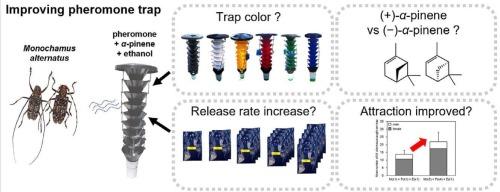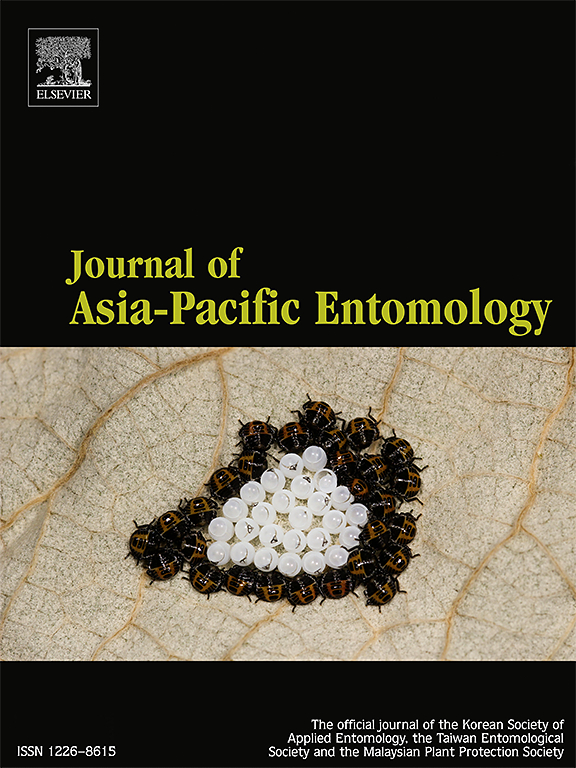诱捕器颜色、单酚和α-蒎烯释放率及α-蒎烯对映体对野田鼠捕获的影响(鞘翅目:天牛科)
IF 1.3
3区 农林科学
Q3 ENTOMOLOGY
引用次数: 0
摘要
松材线虫(PWN)是松材线虫(PWN)的一种已知媒介,是松材线虫病的致病因子。有效控制这一病媒对于防止PWN的传播至关重要。虽然信息素诱捕器已被用于监测交替田鼠的季节性发生,但尚未作为一种实用的田间害虫防治方法。因此,为了利用信息素诱捕器减少病媒种群,必须提高诱捕效率,使其超过目前用于监测目的的水平。本研究通过田间试验,评价了不同信息素诱捕条件下,通过改变诱捕器颜色、α-蒎烯对映体、信息素和α-蒎烯的释放率来提高野田鼠对野田鼠的吸引力。在6种被试颜色中,黑捕鼠器对交替田鼠的吸引力最大。在α-蒎烯的对映体偏好测试中,不同对映体间的反应无显著差异。为了评估信息素和α-蒎烯释放率对野田鼠捕获的影响,采用释放不同释放率的单酚(7-35 mg/d)和(−)-α-蒎烯(13-65 mg/d)的诱捕器作为诱饵。使用单甘油醇(35 mg/d)和(−)-α-蒎烯(52 mg/d)释放速率的捕集器捕获效率最高,比使用最低释放速率(单甘油醇:7 mg/d;(−)-α-蒎烯:13 mg/d)的捕集器捕获效率高59.8%。值得注意的是,虽然雄性捕获量没有显著差异,但具有最佳释放率的陷阱捕获的雌性多60.5%。虽然这项研究的重复次数有限,陷阱间距相对较短,但研究结果为优化陷阱性能提供了有价值的见解,并为制定更有效的防治策略奠定了基础。本文章由计算机程序翻译,如有差异,请以英文原文为准。

Effect of trap color, monochamol and α-pinene release rates, and α-pinene enantiomers on the capture of Monochamus alternatus Hope (Coleoptera: Cerambycidae)
Monochamus alternatus Hope (Coleoptera: Cerambycidae) is a known vector of the pine wood nematode (PWN), the causal agent of pine wilt disease. Effective control of this vector is essential to prevent the spread of PWN. Although pheromone traps have been employed to monitor the seasonal occurrence of M. alternatus, they have not yet been adopted as a practical method for field-level pest control. Therefore, to utilize pheromone traps for reducing vector populations, their trapping efficiency must be enhanced beyond the levels currently used for monitoring purposes. In this study, various pheromone trap conditions were evaluated through field trials to enhance the attraction of M. alternatus by modifying trap color, α-pinene enantiomers, and the release rates of pheromone and α-pinene. Among six tested colors, M. alternatus was most strongly attracted to black traps. In the enantiomer preference test for α-pinene, M. alternatus showed no significant difference in response among the different enantiomers. To assess the effects of pheromone and α-pinene release rates on M. alternatus capture, traps were baited with lures emitting varying release rates of monochamol (7–35 mg/day) and (−)-α-pinene (13–65 mg/day). Traps using the release rates of monochamol (35 mg/day) and (−)-α-pinene (52 mg/day) that resulted in the highest captures were 59.8 % more effective than those using the lowest release rates (monochamol: 7 mg/day; (−)-α-pinene: 13 mg/day). Notably, while there was no significant difference in male captures, traps with the optimal release rates captured 60.5 % more females. Although this study was conducted with limited replicates and relatively short trap spacing, the findings provide valuable insight into optimizing trap performance and lay the groundwork for developing more effective control strategies against M. alternatus.
求助全文
通过发布文献求助,成功后即可免费获取论文全文。
去求助
来源期刊

Journal of Asia-pacific Entomology
Agricultural and Biological Sciences-Insect Science
CiteScore
2.70
自引率
6.70%
发文量
152
审稿时长
69 days
期刊介绍:
The journal publishes original research papers, review articles and short communications in the basic and applied area concerning insects, mites or other arthropods and nematodes of economic importance in agriculture, forestry, industry, human and animal health, and natural resource and environment management, and is the official journal of the Korean Society of Applied Entomology and the Taiwan Entomological Society.
 求助内容:
求助内容: 应助结果提醒方式:
应助结果提醒方式:


